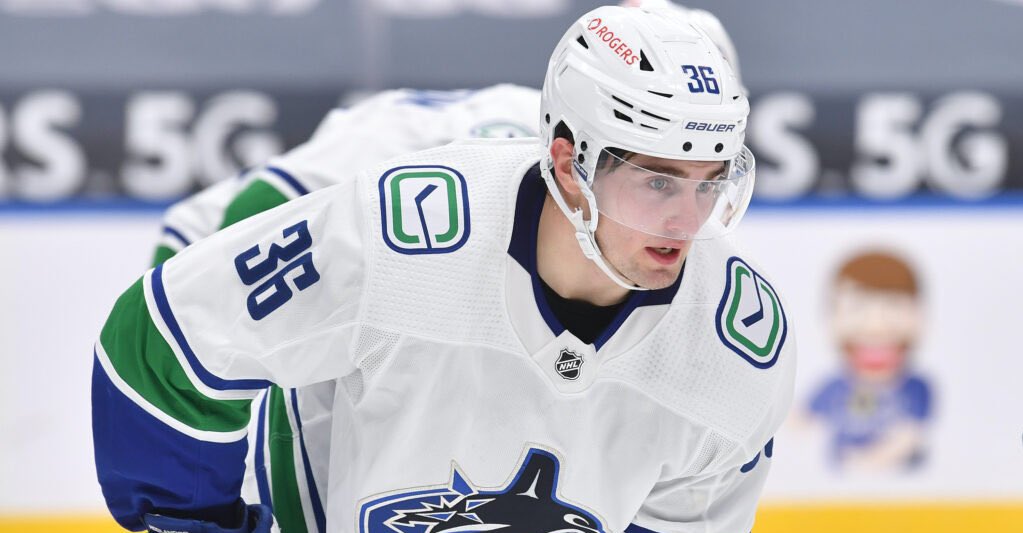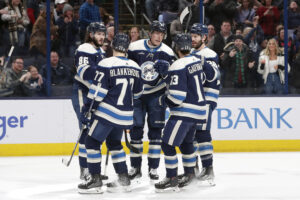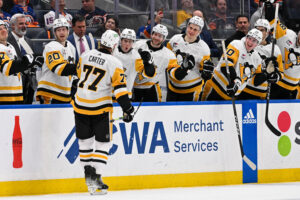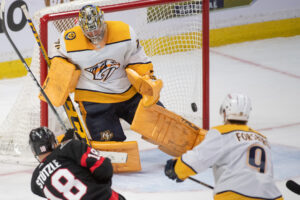Every season fans on the West Coast discuss possible Vancouver Canucks bounceback players. That’s been driven by a lack of success on the ice, but hey! The pre-season is all about optimism, right? Sure, they’ve only won one [1] playoff round in eleven seasons, and only made* the playoffs once in seven. But THIS could be the year!
It can also be the year players who had good seasons slip back for whatever reason. Not all surprises are pleasant ones, after all – and every NHL season brings surprises. We’ll get into those guys next column, but for now? Pure Optimism, Baby!
(Don’t Call It A) Canucks Bounceback Players
That all being said, comforting lies have their use. It helps shake off depressing results, for instance. Another example is the so-called “Sophomore Slump” where a first-year player has a great season and then comes back to Earth a bit the next year. It can be caused by many different things, including the player relaxing a bit in Year Two, opponents paying more attention to them, regression to the mean, or just plain old luck.
Nils Höglander
Nils Höglander is a TON of fun to watch. He has a never-ending engine going, loves stealing the puck, and brings both speed and quickness to a team that needs both. Plus anyone who has a soft spot for undersized wingers has got to love the 5’9″ fire plug. That he ended up making the lineup in his first season was a pleasant surprise for everyone. What he did with the opportunity was even more so: 13 goals and 27 points in just 56 games made him a top-five scorer as Elias Pettersson missed half the season.
GAME DAY: Nils Hoglander continues to make a strong impression on #Canucks coaches and teammates – https://t.co/MTCUxKOB1G#TSNHockey pic.twitter.com/o6Sis1OomV
— TSN Hockey (@TSNHockey) February 21, 2021
Then the next season Pettersson played the full year and the team got off to a miserable start. A new coach came in and tossed players in the blender to find out who was who. Höglander’s ice time dropped as other players formed up on the top two lines. His scoring dropped to 10 goals and 18 points in 60 games, and he was an occasional healthy scratch. This year it looks like he’s not going to get a chance in the top six. If he starts at all, it will probably be on the fourth line.
So why do we expect a bounceback? Pretty simple: when Höglander played with linemates that matched his energy, they dominated. The forward lines have changed enough that the most likely fourth line is Höglander with Tanner Pearson and new arrival Curtis Lazar. Fans may disparage him, but Pearson improves every line he’s on. Pearson – Lazar – Höglander is an upgrade on Juho Lammikko – Tyler Motte – Matthew Highmore. Getting a regular role with established linemates will only help – especially if they are played as a scoring threat.
Jason Dickinson
Speaking of regression to the mean, Jason Dickinson stands to be a poster child for the effect. Another player who missed a quarter of the season, Dickinson didn’t play badly so much as never found his role in 2022-23. Joining a new team in a tumultuous season didn’t help, but there was also an expectation of stability for him. His former team didn’t seem to know who he was, either, and the move to Vancouver was supposed to be into a nicely defined role. As we discussed before, it wasn’t.
How how is this year going to be better? Partially, it will be a reduction in expectations. His overall play wasn’t great, but he did shut down opponents’ scoring chances. He suppressed shots everywhere, in fact, including on the Vancouver Canucks. Not the result they wanted, perhaps, but what they got. Dickinson would have been buried for it if he were any cheaper.
It looks like Vancouver is going to run three-deep at centre this year, which will push Dickinson to the wing. That’s not a bad place to start if he gains consistency. A regular role on a regular line – possibly beside Höglander and Lazar if Pearson stays up – can help him define expectations. He has some bit of scoring, but really Dickinson should be a shut-down guy. Hopefully, he gets back over the 20-point mark, but his success will be determined by who scores against him.
Oliver Ekman-Larsson
There is a question about Oliver Ekman-Larsson‘s game from last year: was it “bad”? Like with Dickinson, it was if the expectations leading into the season are the guide. Five goals and 29 points in 79 games is his lowest offensive output in a decade. And, unfortunately, anyone being paid $7.26 million is expected to score a whole lot more than that. His usage this season, on the other hand, may well encourage that.
In 2022-23, Ekman-Larsson was primarily used as half of a shutdown pair with Tyler Myers. That’s something of a shocking use for Myers, but it worked reasonably well for most of the year. With discussion turning to Vancouver’s general weakness on the right side, there is speculation Ekman-Larsson will be moved over. That would shore up the right at the expense of the left, leaving them with Quinn Hughes, Travis Dermott (maybe) and Jack Rathbone (probably). The problem isn’t depth on the right side, but depth. So why consider Ekman-Larsson one of the Canucks bounceback players?
The two options are using him in a pair with Hughes – which means added scoring – or finding another match. Vancouver’s actual problem is needing a top-pair defenceman when they have four third-pair guys, but everyone needs to make do. If the team can bring in someone who works beside Hughes, or even if they want more scoring, there is an option. Letting Ekman-Larsson go on the attack more frequently would make them a dangerous team 40 minutes a night. When he wasn’t beside Myers, Ekman-Larsson dominated expected goals with everyone except for Noah Juulsen and… Quinn Hughes. With Luke Schenn, Tucker Poolman, or even Kyle Burroughs or Brad Hunt Ekman-Larsson was well over 50%.
Either he lines up beside Hughes, or he becomes the attacker in a classic attacker/defender pairing. Both those choices makes Ekman-Larsson an ideal Canucks bounceback nominee.
*It counts. Shut up.






